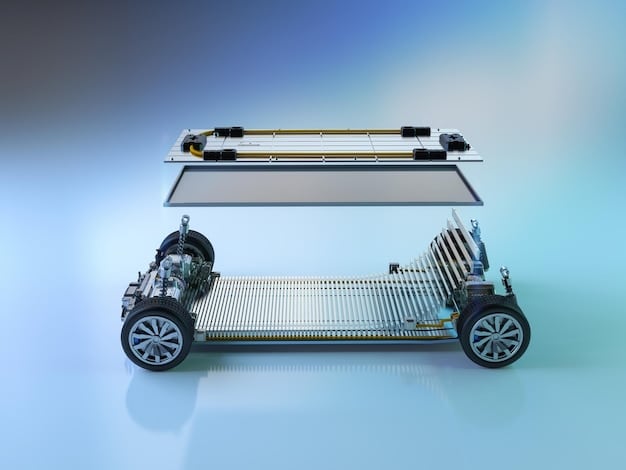The Future of Electric Vehicles: Battery Tech & Environmental Impact

The future of electric vehicles (EVs) hinges on advancements in battery technology, with ongoing innovations aimed at improving energy density, charging times, and environmental sustainability, ultimately reducing the carbon footprint associated with transportation.
The automotive industry is undergoing a seismic shift, with electric vehicles (EVs) poised to dominate the roads. The heart of this revolution lies in battery technology, the driving force behind the performance, range, and environmental impact of EVs. Understanding the nuances of different battery technologies is crucial for navigating the future of electric vehicles: a comparison of battery technologies and their environmental impact.
Understanding the Current Landscape of EV Batteries
Electric vehicles rely on batteries to store and deliver the energy needed for propulsion. The current EV market is dominated by lithium-ion batteries, but ongoing research and development are constantly pushing the boundaries of what’s possible. Let’s delve into the present state of EV battery technology.
Dominant Battery Technologies in Use
Currently, lithium-ion batteries are the most prevalent choice for EV manufacturers due to their high energy density and relatively long lifespan. However, they’re not without limitations.
Other battery technologies are emerging and offer solutions to Lithium-ion’s limitations like charging time and environmental effects.
- Lithium-ion (Li-ion): These batteries offer high energy density and a relatively long lifespan, making them a popular choice for EVs today.
- Nickel-Metal Hydride (NiMH): While less common in pure EVs, NiMH batteries are used in hybrid vehicles due to their safety and durability.
- Solid-State Batteries: Promising higher energy density and improved safety compared to Li-ion, solid-state batteries are a key area of development for the future.

The industry’s battery technology segment is ripe with innovation, and these new chemistries promise to reshape the paradigm of EV battery performance.
Advancements in Lithium-Ion Battery Technology
While lithium-ion batteries are currently the standard, significant advancements are being made to improve their performance and address their limitations. These advancements promise to extend range, reduce charging times, and enhance safety.
New Materials and Chemistries
Researchers are exploring new materials and chemistries to enhance the performance of Li-ion batteries. This includes using different cathode materials like nickel-manganese-cobalt (NMC) and lithium iron phosphate (LFP).
These novel chemistries promise to reshape the paradigm of EV battery performance.
Key Improvements in Energy Density and Charging Times
One of the primary goals is to increase the energy density of batteries, allowing vehicles to travel farther on a single charge. Simultaneously, innovations are focused on reducing charging times to make EVs more convenient for drivers.
- Silicon Anodes: Replacing graphite with silicon in the anode can significantly increase energy density.
- Fast Charging Technologies: New charging protocols and battery designs enable faster charging times, reducing downtime for EV drivers.
- Improved Thermal Management: Advanced cooling systems prevent overheating and improve battery lifespan and performance.
Improvements and innovation will make EVs attractive for consumers that depend on quick recharge times.
The Promise of Solid-State Batteries
Solid-state batteries are considered a potential game-changer in the EV industry. Replacing the liquid electrolyte with a solid material offers several advantages, from increased safety to higher energy density.
New technologies will improve upon current battery limitations.
How Solid-State Batteries Differ
Unlike traditional lithium-ion batteries, solid-state batteries use a solid electrolyte, which is less flammable and more stable. This enhances safety and allows for higher energy density.
Advantages of Solid-State Technology
Solid-state batteries offer several compelling advantages over traditional lithium-ion batteries. These include:
- Enhanced Safety: The solid electrolyte is non-flammable, reducing the risk of fires and thermal runaway.
- Higher Energy Density: Solid-state batteries can store more energy in a smaller volume, increasing vehicle range.
- Faster Charging: The solid electrolyte allows for faster ion transport, enabling quicker charging times.
Solid-state batteries are poised to be the future with their enhanced safety and charge properties.

Environmental Impact of EV Batteries
While EVs are often touted as a greener alternative to gasoline vehicles, it’s crucial to consider the environmental impact of battery production, use, and disposal. A holistic approach is needed to ensure the sustainability of EVs.
Lifecycle Assessment of EV Batteries
A comprehensive lifecycle assessment examines the environmental impact of EV batteries from raw material extraction to end-of-life management. This includes energy consumption during manufacturing, transportation emissions, and the potential for recycling and reuse.
Recycling and Responsible Sourcing
Effective recycling processes are essential for minimizing the environmental impact of EV batteries, while responsible sourcing of raw materials ensures ethical and sustainable practices.
- Recycling Technologies: Developing advanced recycling technologies to recover valuable materials like lithium, cobalt, and nickel.
- Responsible Mining Practices: Implementing ethical and environmentally responsible mining practices to minimize the impact of raw material extraction.
- Second-Life Applications: Exploring second-life applications for EV batteries, such as energy storage in residential and commercial settings.
Consideration and care should be used in every step of the battery’s lifecycle to ensure minimal effects of the environment.
The Role of Battery Management Systems (BMS)
Battery Management Systems (BMS) play a critical role in optimizing the performance, safety, and lifespan of EV batteries. These sophisticated systems monitor and control various parameters to ensure efficient and reliable operation.
These monitoring systems extend the life and improve the utility of EV battery systems.
Key Functions of a BMS
A BMS performs several essential functions, including:
- Monitoring cell voltage and temperature to prevent overcharging and overheating.
- Balancing cell charge to ensure uniform energy distribution and maximize battery capacity.
- Estimating state-of-charge (SOC) and state-of-health (SOH) to provide accurate information to the driver.
Advancements in BMS Technology
Ongoing advancements in BMS technology are enhancing its capabilities and improving the overall performance of EV batteries. This includes:
- Predictive Algorithms: Utilizing machine learning to predict battery degradation and optimize charging strategies.
- Wireless BMS: Reducing wiring complexity and improving reliability with wireless communication between battery cells and the control unit.
- Integration with Vehicle Systems: Seamless integration with other vehicle systems, such as the powertrain and thermal management system, to optimize energy efficiency.
Better understanding of the battery enables the vehicle to maximize the use of it and improve the ownership experience.
Future Trends and Innovations
The future of EV batteries is filled with promising trends and innovations that will further transform the automotive industry. From next-generation battery chemistries to advanced charging technologies, the possibilities are vast.
There are almost limitless potential avenues for growth in the battery sector.
Next-Generation Battery Chemistries
Researchers are exploring a variety of next-generation battery chemistries that could offer significant improvements over current lithium-ion technology. These include:
- Lithium-Sulfur (Li-S) Batteries: Offering the potential for higher energy density and lower cost compared to Li-ion.
- Sodium-Ion (Na-ion) Batteries: Utilizing abundant and inexpensive sodium as an alternative to lithium.
- Magnesium-Ion (Mg-ion) Batteries: Promising increased safety and energy density due to the divalent nature of magnesium ions.
Wireless Charging and Battery Swapping
Wireless charging and battery swapping technologies represent potential solutions for addressing range anxiety and improving the convenience of EV ownership.
- Wireless Charging: Allowing EVs to charge wirelessly via inductive pads embedded in roads or parking spaces.
- Battery Swapping: Enabling drivers to quickly swap depleted batteries for fully charged ones at designated stations.
All of these advancements promise a bright and exciting future for electric vehicles.
| Key Area | Brief Description |
|---|---|
| ⚡ Battery Tech | Improvements focused on increasing energy density and reducing charging times. |
| 🌱 Environmental Impact | Recycling is essential for EVs to promote a completely green vehicle lifecycle. |
| 🔋 BMS | Monitoring systems increase battery life of EV systems. |
| 🚀 Future Trends | Innovations such as wireless charging will further increase adoption of EVs. |
Frequently Asked Questions
▼
Currently, lithium-ion batteries are the most widely used in electric vehicles due to their high energy density and good lifespan. However, research continues on alternative technologies to improve performance and sustainability.
▼
The effects of EV batteries on the environment are complex. While production and disposal can have environmental consequences, EVs generally have a lower carbon footprint than gasoline cars, especially when powered by renewable energy.
▼
EV batteries usually last for 100,000 to 200,000 miles, or about 10 years. Many manufacturers offer warranties that cover battery degradation within a specific timeframe or mileage.
▼
Yes, EV batteries can be recycled. However, the recycling process is complex and varies based on battery chemistry. Efforts are underway and innovating to improve recycling efficiency. This will maximize the recovery of valuable materials.
▼
Solid-state batteries use a solid electrolyte instead of a liquid or polymer gel. They offer higher energy density, improved safety, and faster charging times compared to traditional lithium-ion batteries.
Conclusion
The world of electric vehicle batteries will continue to evolve and improve as the tech matures. As manufacturers push toward higher charge capacity and reduced environmental impact, the future looks bright.





